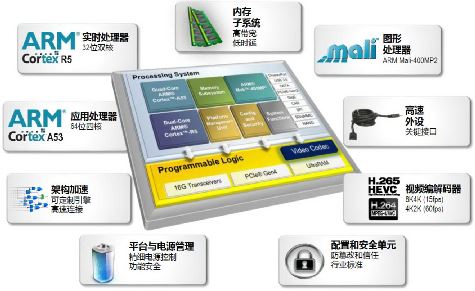
Xilinx, as an industry leader in programmable logic devices (FPGAs), provides a wealth of devices and simple development tools. Here are the following aspects to introduce:
FPGA/SoC : Earlier we all adopted a pure FPGA design, using FPGA resources to implement soft-core processors such as Microblaze, Picoblaze, etc. Now Xilinx has introduced Zynq SoC and Zynq UltraScale+ MPSoC series, which integrates hard-core processors ( Dual-core ARM Cortex-A9 CPU or Quad-A53+Dual-R5 GPU), which not only brings improvements in performance, power consumption, cost-effectiveness, but also reduces the PCB size;
Power Consumption : The Xilinx Zynq UltraScale+ MPSoC series has indeed been greatly improved over previous pure FPGA devices. It supports multiple power modes: Full-Power mode; Low-Power mode; Sleep mode, DRAM pause; Power-Off The mode provides a flexible and flexible power management scheme, with flexible switching between performance and power consumption.
Analog processing : ADC functions were integrated as early as on the Virtex family, but this was limited to monitoring the internal analog components such as voltage and temperature. Afterwards, two 1Msamples/sec@12-bits ADC modules are integrated on the 7 Series to support the acquisition of internal and external analogs. The Zynq UltraScale+ RFSoC integrates higher performance ADCs/DACs modules: 4Gsamples/sec@12 bits ADCs / 6.5Gsamples/sec@14 bits DACs, can be applied to 15G, radar and other fields.
Security : We all know the bitstream format of the FPGA's boot file. The Xilinx Zynq-7000 SoC and Zynq UltraScale+ MPSoC all support the encrypted bitstream, which is loaded into the processor for secure decryption.
It can be seen that FPGA/SoC vendors have spent a lot of effort to optimize devices and improve development tools, making them easier to apply to embedded system design, and our learning process will be easier than in the past, in the near future FPGA/SoC will gain wider application.
Disclaimer: This article is sourced from the Xilinx Xcell Daily Blog. It was compiled by Xilinx Chinese Community, and please indicate the author, source, and original link. https://forums.xilinx.com/t5/Xcell-Daily-Blog/When- and-why-is-it-a-good-idea-to-use-an-FPGA-in-your-embedded/ba-p/820625
Guangzhou Yunge Tianhong Electronic Technology Co., Ltd , https://www.e-cigarettesfactory.com